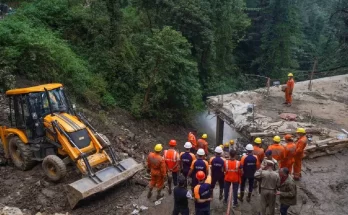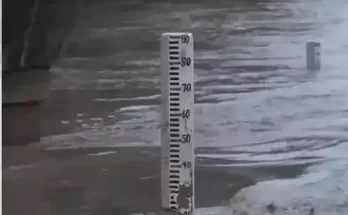Had each of the designated agencies had done their work on time, Delhi could have minimised the damage from the disaster.

A resident rescues a cow from the flood-affected Old Usmanpur village, in New Delhi, Thursday, July 13, 2023 (Photo credit: PTI)
New Delhi: Delhi witnessed an unprecedented flood situation this week. Not just did the Yamuna cross the 1978 flood level record, a breach in one of the channels flooded iconic neighbourhood of the national capital such as ITO, Ring Road and the Supreme Court.
The political blame game ensued in quick time over several issues even as Central and Delhi government agencies carried out rescue operations. Still, there are definite lessons to be learnt for Delhi to ensure that devastation at such a scale isn’t repeated.
Here are the 5 biggest takeaways:
1] Maintain the sanctity of floodplains
Robbing the river of its floodplains is akin to depriving a human any space to move. Apart from the embankments to prevent flood waters spilling over to residential areas, the floodplains in Delhi area have been eroded one chunk at a time. Legal and illegal construction on the floodplains is to be blamed here. Then there is dumping of garbage, a treatment plant for construction debris types of projects that need to be stopped totally. Irrespective of who has done what in the past, the sanctity of the floodplains needs to be respected and maintained.
2] Maintenance of drainage system
When Delhi was being pummelled by the highest rainfall in 40 years on July 8 and 9, the first thing that buckled was its drainage system. Agreed that there was extremely heavy downpour, but nothing can absolve the respective civic agencies of not keeping the drains clean and functional. All agencies need to shirk the ‘chalta hai’ attitude and ensure that pre-monsoon cleaning of the drains is done seriously and diligently. Keeping the storm water drains separate from those carrying sewage should be a priority.
3] Revive dying lakes, ponds and waterbodies
Lakes and ponds act as sponges for absorbing excess water. This isn’t just a sure-shot way of flood mitigation but also ensures groundwater recharge. Delhi had about 1,200 lakes till about 100 years ago. Urbanisation ate into not just many of the natural water bodies but also gobbled up their catchments. Today, the Delhi government claims that there are just 629 waterbodies that can be traced on ground, big and small.
4] Examine functionality of infrastructure
Even when the Yamuna flood waters had inundated large parts of low-lying areas in central and north Delhi and the river was flowing filled to the brim, the real shocker came on July 13. On the one hand, plush areas such as Civil Lines saw water-logging up to 10-15 feet. On the other hand, a breach in one of the channels near Indraprastha Metro Station led to flood waters first filling the entire ITO area and then threatening the Supreme Court of India premises. Five of the sluice gates of the ITO Barrage are dysfunctional as they were never used or repaired. Such negligence of duty by the respective agencies has cost Delhi much damage and this instance should be a grim reminder to the authorities to remain on their toes.
5] Fast response needed on disaster management
Even when there were enough early warnings, Delhi Disaster Management Authority met for the first time on July 12 even when the flood alerts had been issued two days before it. This last minute waking up of the prime agency to deal with a disaster of this kind has taken its toll. Delhi’s unprecedented floods have as much to do with this criminal delay as is the extremely heavy rainfall in the upstream states of Yamuna. Having a disaster management team and ensuring that it works proactively – Delhi can learn from Odisha how it activates its team ahead of cyclones – is a must.
There are hundreds of other things that can be done. But these are the bare minimum. Else, as that famous poem goes, ‘For want of a nail, the battle was lost’, Delhi will keep losing.
(This story first appeared on news9live.com on Jul 15, 2023 and can be read here.)



